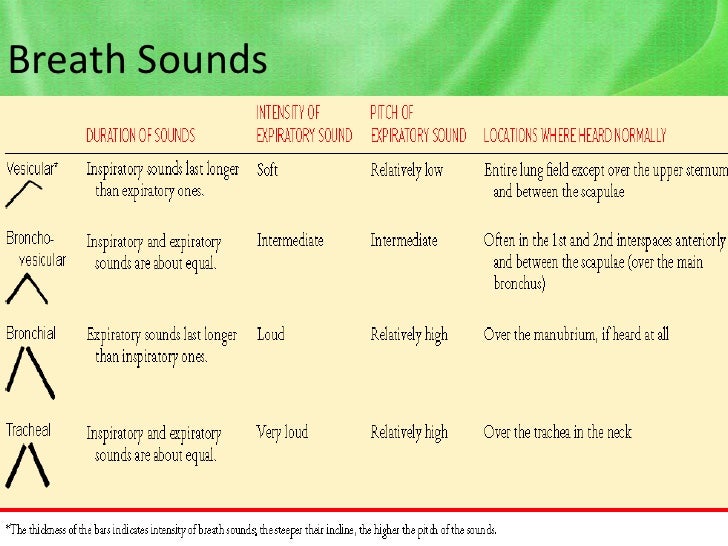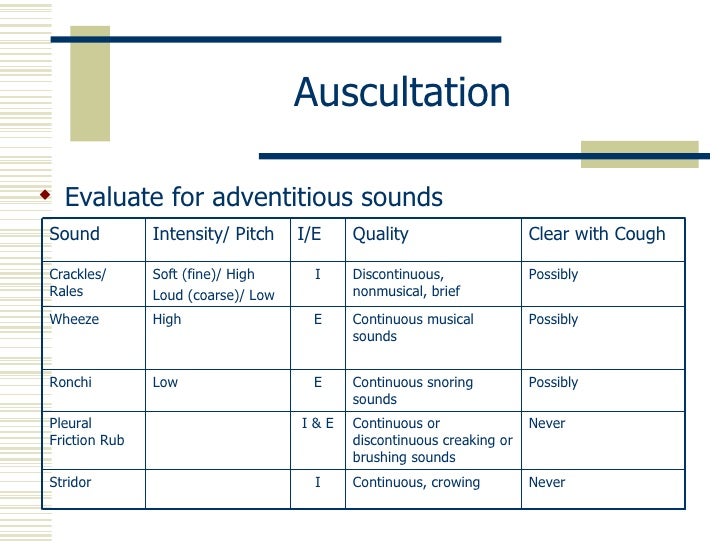Respiratory sounds
Auscultation of the lungs used for diagnosis of diseases of the lungs and is part of the physical examination. Under auscultation is understood in medicine, the auscultation of organs with a stethoscope. As part of the auscultation of the lung breath sounds and noises can be distinguished. The respiratory sounds may be divided into physiological or normal and pathological or abnormal respiratory sounds. Noise of the lung are always pathological.
Physiological breath sounds
Breath sounds caused by turbulent air flow. In contrast, the laminar flow of air is silent. The normal breath sounds are divided into central and peripheral respiratory sounds. The mechanism is the same. They differ in the spectral composition. This is affected by the transmission distance and the sound- conducting medium.
- The central respiratory sound was once called " bronchial ". It can be heard both in single as well as a loud exhalation, medium-to high-frequency noise on the central airways.
- The peripheral respiratory noise was formerly known as " vesicular " or " vesicular breath sounds " and does not arise as assumed earlier in the alveoli (alveoli ). Its origin lies in the central airways, but it is attenuated by the lung tissue and is rather quiet and low frequencies. It is audible in quiet especially during the input and at the beginning of exhalation.
Pathological breath sounds
The abnormal respiratory noise is caused either by an abnormal air conduction of sound or abnormal sound generation. When abnormal noise generation, the breath sounds are either too low, as found in hypoventilation, or too loud, as occurs with hyperventilation or structural changes of the bronchial tree.
- Bronchial (English bronchial breath sounds): The sound of breathing is enhanced if the damping is reduced, as is the case of pneumonia (pneumonia) or a collapsed lung ( atelectasis ) in the upper lobe of the lung is the case. The breath sounds can be heard in healthy only centrally via the trachea, it is auscultated in the periphery, it is considered pathological.
- An attenuated breath sounds ( engl: attenuated breath sounds): Toned the respiratory sound is either enlarged transmission distance, as in hyperinflation (eg asthma and emphysema) is the case, or by increasing the damping factors, eg pneumothorax, pleural effusion, pleural thickening or Unterlappenatelektase.
Not to be confused with pulmonary breath sounds are noise.
Pulmonary noise
Pulmonary noises in diseases of the respiratory organs or of organs, which affect the breathing. The classification is based on a historically based naming, which was based on the pathological findings section of sufferers.
Intermittent noise
Intermittent noise (formerly damp or non-musical Rassel-/Nebengeräusche ) can be further divided into coarse to fine bubble rales. Mucus and secretions bubbles solve, depending on its consistency and localization in the small to large airways noises, which are roughly comparable to the sound of the rising and bursting bubbles when you open a soda can. Coarse -bubble rales caused by secretions in the larger airways such as the trachea and bronchi, fine bubble by secretions in the smaller airways, such as the small bronchi and alveoli.
A special form is the Knisterrasseln ( Sklerosiphonie ). It is a sound that can be compared with the injection of hot oil in a frying pan or the rupture of a Velcro fastener. It is found in a lung fibrosis.
See also article: rattle noise
Continuous noise
Continuous noise (formerly dry or musical Rassel-/Nebengeräusche ) are stridor, buzzing, whistling, wheezing. Narrowing of airways by viscous secretions, often in conjunction with mucosal swelling, trigger an accelerated flow which produces audible vibrations of the air column in the airways. They sound more melodic than intermittent noise.
- Hum (English rhonchi ) is a low frequency noise generated by irregular, changing pads and floating threads of slime in the large airways. By blowing between two closely held together sheets of paper, creating a buzzing sound, which ceased with the cessation of the breath stream.
- Whistling / wheezing (English wheeze ). Pipe is a high frequency noise that occurs as a severe narrowing of the airways by mucus or contraction of airways. Pipe is produced in everyday life in the squeaky sounding evacuation of a gas from a reservoir with a narrow outlet. Wheezing is the orchestral sounding together of breathing air that escapes hampered by restricted smallest airways ( bronchioles ) in the large airways. Whistling and wheezing are often used interchangeably. This respiratory sound is typically for a chronic obstructive pulmonary disease ( COPD) and asthma.
- Stridor is a case of inhalation or exhalation audible over the air tube flow noise, which can be propagated through the oral cavity to the outside. A stridor is produced at a constriction in the larynx or trachea.










